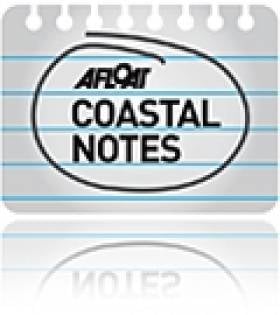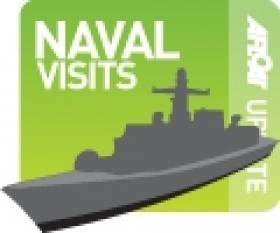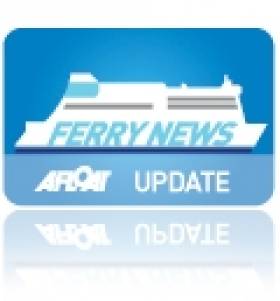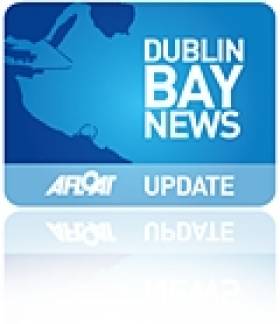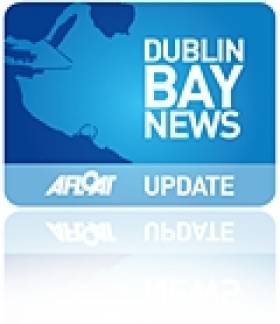Displaying items by tag: Dun Laoghaire Harbour
Screening Shown of Unique Lives Lost at Sea Ceremony
#MARINERS WITH MEMORIES – At the weekend representatives of the maritime community, relatives and visitors alike attended a screening of the 'Mariners with Memories' ceremony, which was shown in the Maritime Museum, Dun Laoghaire.
The ceremony which took place in Bray Harbour last July, is unique in that it recognises to all those lost to sea throughout the world and especially to those whose grave is the sea.
Shot by Colm Fynes, the film documented the day's proceedings with tributes made at the Co. Wicklow harbour and the flotilla that followed with floral tributes carried out close to the shore.
Captain Tony O'Grady who organised the Mariners with Memories ceremony, thanked all those to the museum and the support of the Maritime Institute of Ireland, whose newly renovated museum was a particularly apt venue, being the former Mariners Church.
Some of the relatives who attended the memorial event in Bray were also at the Dun Laoghaire screening and where they gave moving tributes to loved ones.
Commenting on the poignancy of the screening, Captain O'Grady referred to the on-going tragic events in Glandore Harbour and off the Italian island of Giglio.
He added that those involved in the various services off the West Cork fishing harbour would of liked to have attended but given the circumstances, all the resources were required at the scene.
It is hoped that following the inaugural ceremony, that Mariners with Memories will become an annually held event and the close relationship with the museum continues.
The museum which was especially opened for the screening will remain closed throughout the winter months though is open on an invitation only basis. Officially the museum is due to re-open this Easter, to keep posted of further developments visit www.mariner.ie
Naval School-Ships to take Class to Dublin
#NAVAL VISITS - The first foreign naval visitors to Dublin Port in 2012 will be the French Navy, as five of an eight-strong class of school-training ships from Brest are due to dock on Friday, writes Jehan Ashmore.
The octet belong to the Léopard class though the namesake leadship, Léopard (A 748) and Jaguar (A 750) will not be forming as part of the visiting flotilla.
Those that will be making the weekend port of call, berthing at Sir John Rogersons Quay will be Panthère (A 749) and Lynx (A 751) both commissioned in 1982 and the remaining quartet Guépard (A 752); Chacal (A 753); Tigre (A 754) and Lion (A 755) which entered service the following year. For a photo of the latter vessel and one of her sisters the Chacal click HERE.
Each of the 44 tonnes vessel's measure 17.5m long and have a beam of 6.40m and drawing a draft of 2.40m. To read more on the class characteristics click HERE.
The class follow in the wake of the last French Naval vessel to enter Dublin Bay, PSP Cormoran (P677). The OPV provided guard-ship duties when accompanying the Solitaire du Figaro race fleet during the stopover to Dun Laoghaire Harbour last August, as previously reported on Afloat.ie
On The TV: Sky's 'Treasure Island'
#ON THE TV – As previously reported on Afloat. ie, the first of a new two-part adaptation of Treasure Island which was partially shot in Ireland is to screened tonight at 7pm on the Sky HD 1 and Sky 1 channels and tomorrow evening at 7pm.
The classic Robert Louis Stevenson 18th century tale was directed by Dubliner Steve Barron and the leading role of the one-legged pirate, Long John Silver was played by Eddie Izzard. Joining the Emmy award winning Izzard is the BBC TV series Spooks actor Rupert Penry-Jones and Hollywood stars Donald Sunderland and Elijah Wood.
Square Sail's barque Earl of Pembroke was based in Dun Laoghaire Harbour late last year. On one occasion the 174-tonnes barque was seen off The Muglins Lighthouse, Dalkey Island, where a camera-equipped helicopter whirled above the former Baltic Sea trader in Dublin Bay. Following the shoot in Ireland, the production team for the made for TV drama re-located to Puerto Rico in the Caribbean.
Ahoy Me Irish Hearties as “Treasure Island” Sets Sail for TV Screenings
#ON THE TV-It's just over a year ago to when filming took place for parts of the TV Movie "Treasure Island" off Dalkey Island, as previously reported on Afloat.ie. Fans of the classic Robert Louis Stevenson 18th century tale can look forward to this new two-part adaptation starring Eddie Izzard as the one-legged pirate, Long John Silver, on New Year's Day on Sky 1 HD at 7pm and also at the same time on 2nd January, writes Jehan Ashmore.
Joining the Emmy award winning Izzard is BBC TV series Spooks actor Rupert Penry-Jones and Hollywood stars Donald Sunderland and Elijah Wood.
The nautical scenes where set on board Square Sails tallship, the barque Earl of Pembroke which used Dun Laoghaire Harbour as a base. During the Irish scenes, the production crew and members of the cast had to endure the bitterly artic-like conditions of last winter's big freeze as the 174-tonnes barque was off The Muglins Lighthouse with a camera-equipped helicopter whirling above.
Following the shoot in Ireland which involved Dun Laoghaire based Parallel Film Productions and the Irish National Sailing School (INSS) which provided marine co-ordination services for the drama commissioned by Sky 1 HD TV Chanel, the shoot re-located to Puerto Rico in the Caribbean.
To watch a first look-official trailer of the long-awaited swashbuckling adventure click HERE and for more about the drama including a Q&A with the cast click HERE.
- Dublin Bay News
- Treasure Island
- Parallel Film Productions
- Dun Laoghaire Harbour
- Irish National Sailing School (INSS)
- Dalkey Island
- INSS
- Eddie Izzard
- Robert Louis Stevenson
- Rupert PenryJones
- The Muglins
- Maritime TV Programmes
- Sky 1 HD Channel
- TV Movie 'Treasure Island'
- Donald Sunderland
- Eliyah Jones
- On The TV
- BBC TV series Spooks
- Square Sails
- The Muglins Lighthouse
Anglo-Irish Relationships
#NAVAL VISITS- HMS Tyne (P281) the leadship of four River-class Fishery Protection Vessels is due to dock in Dublin Port tomorrow, in the meantime her allocated berth is currently taken by a former Royal Navy (RN) vessel now serving in the Irish Naval Service (INS), writes Jehan Ashmore.
The INS L.É. Ciara (P42) docked at Sir John Rogersons Quay (berth No.8) yesterday evening after spending the previous day with a call to Dun Laoghaire Harbour's St. Michaels Wharf. Tomorrow she is due to depart in advance of HMS Tyne's morning arrival.
Unusually she and her three sisters are leased to the RN from BAE Systems (who retain responsibility for any major maintenance and upkeep) and shipbuilding partners, Vosper Thornycroft, Southampton which built all of the River-class. To read more about the quartet click HERE.
L.É. Ciara was originally launched as HMS Swallow (P242) at Hall Russell Shipyard, Aberdeen and in 1984 was commissioned for the RN, forming one of five 'Peacock' class coastal patrol vessels (CPV). She served her entire RN career with sisters designed specifically for the Hong Kong Squadron.
In 1988 the INS purchased her alongside a sister HMS Swift (P243) and the pair set sail from the UK colony for Cork Harbour. L.É. Ciara and her sister which became L.É. Orla (P41) were commissioned into the service after a ceremony performed by An Taoiseach C.J. Haughey at the Naval Base in Haulbowline.
Amongst the eight-strong INS fleet is L.É. Emer (P21) commissioned in 1978, an improved version of the Deirdre-class offshore patrol vessel (OPV). She appeared along with a sister of the River-class ship, HMS Severn in the Irish language river series 'Abhainn' which returned to our screens on RTE 1 last month, during the episode about the River Foyle /An Feabhal. The naval vessels were attending 'Foyle Days' in May as previously reported on Afloat.ie
- Irish Naval Service
- Dublin Port
- naval service
- Royal Navy
- Dun Laoghaire Harbour
- Peacock Class
- Hall Russell
- Foyle Days
- Naval Visits
- River Foyle
- Coastal Patrol Vessels
- HMS Tyne
- RN
- INS
- Hong Kong Squadron
- Fishery Protection Ship
- BAE Systems
- Vosper Thornycroft
- Haulbowline Naval Base
- Deirdreclass
- Abhainn TV series
- HMS Severn
- Irish River TV series Abhainn
T.D.’s to Strut their Stuff in aid of Maritime Museum
The fundraiser event which is in aid of the Development Fund of the museum, is to take place this Thursday evening (8 p.m.) on 10th November, in the National Yacht Club (NYC) along the waterfront of Dun Laoghaire Harbour, close to the East Pier.
Tickets costing €20 are available from the Maritime Institute of Ireland's (M.I.I.) museum office located on the top floor of the Dun Laoghaire Shopping Centre, in local fashion shops and by contacting (01) 214 3964.
At the end of last month, the M.I.I. celebrated its 70th anniversary which was founded in 1941. To read more about the museum which is undergoing renovation and due to re-open in March 2012 click HERE and to read other news and developments visit www.mariner.ie
- National Yacht Club
- Dublin Bay News
- Maritime Institute of Ireland
- Dun Laoghaire Harbour
- M.I.I.
- Richard Boyd Barrett
- nyc
- Dun Laoghaire Harbour News
- National Maritime Museum
- East Pier Dun Laoghaire
- Irish Maritime Museum's
- Independent T.D's
- Luke 'Ming' Flanagan
- Mick Wallace
- Captain Roger's
- Irish T.D's
- Dun Laoghaire Shopping Centre
- Dun Laoghaire Waterfont
- Dublin Bay yacht clubs
Photo Exhibition: People of the Sea / Gens de la Mer
Gilles Perrin selected his subjects by visiting harbours and piers in locations such as Cobh, Baltimore, Castletownbere and Schull. The work was conducted through the Artist in residency programme at Sirius Arts Centre, Cobh and later by a similar residency position at the West Cork Arts Centre which took place over a few months in 2007 & 2008.
People of the Sea is organised in partnership with Veolia Environnement, also the name given for a new MOD70 class (Multi One Design). Veolia Environnement is one of only 12 such high-spec performance yachts which visited Dublin Bay in the summer calling to Dun Laoghaire and a transit of Dalkey Sound (PHOTO's). She was in Irish waters under the skipper Roland Jourdain and crew ahead of her first test, the Fastnet Race held in mid-August. To read more about Veolia Environnement click HERE and also www.canyousea.com/en/
The other participants of the exhibition which have lent their support are the Sirius Arts Centre, The Arts Council, Cork County Council and The West Cork Arts Centre, and iophotoworks. For more information about Perrin who has a master's Degree in photography visit www.art-contemporain.eu.org/perrin/
- Schull
- Baltimore
- Cobh
- castletownbere
- Dublin Bay News
- Dun Laoghaire Harbour
- Fishing News
- Cork County Council
- Sailing news
- Dalkey Sound
- Veolia Environnement
- French Photographer Gilles Perrin
- Gilles Perrin
- People of the Sea/Gens de la Mer
- Alliance Francaise Dublin
- French Cultural Centre Dublin
- Irish Fishing Harbours
- Sirius Arts Centre
- The Arts Council
- West Cork Arts Centre
- The Fastnet Race
- MOD70 class
- Multi One Design
- Irish Fishing Industry
- Roland Jourdain
Farewell as Stena Line’s ‘Lynx’ Fast-Ferry Sets Sail for South Korea
Sunflower 2 is to make bunker calls on the repositioning voyage, firstly in Valletta, Malta before she transits the Suez Canal to the Red Sea port of Jeddah, Saudi Arabia and Columbo, Sri Lanka. From there she transits the Strait of Malacca then through the South China Sea followed by the East China Sea before finally entering the Strait of Korea to her homeport of Busan.
Since 1999 she has served Stena Line's fast-ferry high-season Rosslare-Fishguard route sailings taking 1 hour 50 minutes in tandem with conventional ferry Stena Europe (1981/24,828grt) which currently maintains the year-round 3 hours 30 minutes route. It is believed that Stena Line will not be operating high-season fast-ferry services in 2012.
Prior to her Dun Laoghaire departure, her South Korean crew have been preparing the craft over the last three weeks. Notably there was the removal of all Stena Line corporate livery markings on the hull. Her new name and port of registry were painted at the stern though she retained her original name at the bow which included both symbols of an Irish shamrock aptly to starboard (green) and the Welsh dragon to port (red) to reflect her Irish Sea southern corridor route.
Stena Lynx III departing Dun Laoghaire last year, note her starboard 'Shamrock' at the bow.
In recent years on the St. Georges Channel route she was marketed as the Stena 'Express'. Her final sailing this year was 4 September and three days later she docked Dun Laoghaire at St. Michaels Pier. On the adjacent berth which is designed specifically for and only capable of accommodating the HSS 1500 class fast-ferries.
Stena Lynx III also ran several shoulder season stints on the Dun Laoghaire-Holyhead route with the HSS Stena Explorer (1996/19,638grt) only running during the busier summer months. During this summer all sailings were maintained by HSS Stena Explorer until the route became a seasonal-only service for the first time this year when the last sailing took place in mid-September. The HSS remains in layover for the winter in Holyhead at her dedicated berth. The route is due to re-open in April or May.
The 35 knot Stena Lynx III was launched from fast-ferry catamaran specialists InCAT Pty based in the Tasmanian capital of Hobart. Early in her career the 81m wave-piercing catamaran (WPC) craft served Dover-Calais followed by two seasons between Newhaven-Dieppe when renamed P&O Elite for joint operators P&O Stena Line.
Her predecessors the WPC InCat 74m Stena Sea Lynx, became the first car-carrying catamaran to operate Dun Laoghaire-Holyhead sailings in 1993. The pioneering water-jet propelled craft was replaced in subsequent years by the larger InCAT 78m Stena Lynx II.
She was replaced in 1996 when the revolutionary four gas-turbine engine water-jet propelled HSS Stena Explorer was introduced. A further two sisters of the HSS 1500 class (High-speed Sea Service) were completed by Finnyards in Rauma.
- Dublin Port
- Dublin Bay News
- HSS Stena Explorer
- Dun LaoghaireHolyhead
- Stena Lynx III
- Ports and Shipping
- Dun Laoghaire Harbour
- Stena Line
- Ports and Shipping News
- Ferry news
- DoverCalais
- HSS
- RosslareFishguard
- Stena Express
- InCat
- Finnyards
- Dun Laoghaire Harbour News
- Irish Sea fastferries
- Sunflower 2
- P&O Elite
- Highspeed Sea Service
- St.Michaels Pier Dun Laoghaire
Work In Progress in Dun Laoghaire Maritime Museum
Following the one-day soft-opening, any group which wishes to visit the museum by appointment should contact the MII's Tel: (01) 280 0969 or you can also call (01) 214 3934.
To read more about the renovation programme click HERE. If you would like to assist through voluntary work, fund-raising activities or make a donation in addition to keeping abreast of news, events and winter lecture programme visit www.mariner.ie
Dun Laoghaire’s Maritime Museum Set for Re-Opening
At the end of this month the M.I.I. will celebrate the 70th anniversary of its foundation and it is the intention of the voluntary run museum to 'officially' re-open in March 2012.
To read more about the renovation programme click HERE. If you would like to assist through voluntary work, fund-raising activities or make a donation in addition to keeping abreast of the latest developments visit www.mariner.ie
View Larger Map


























